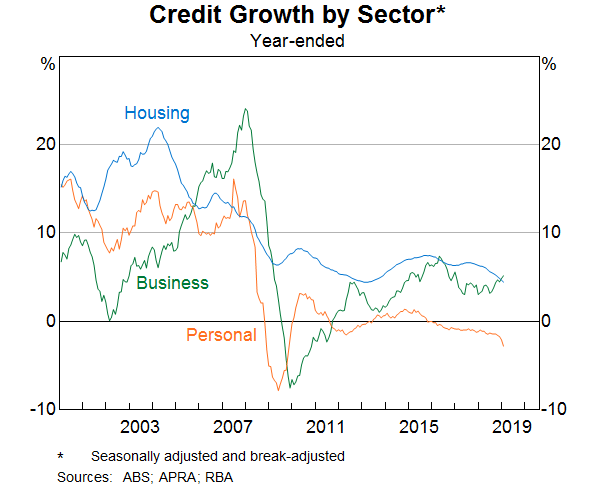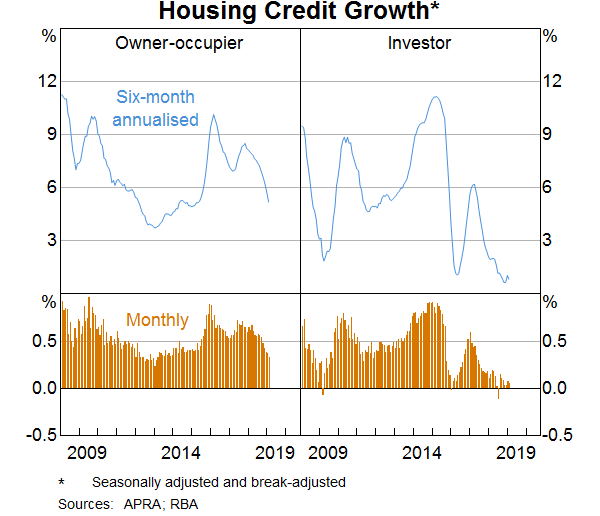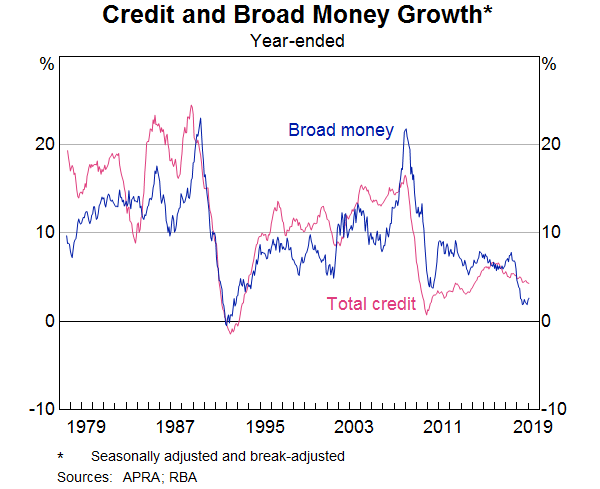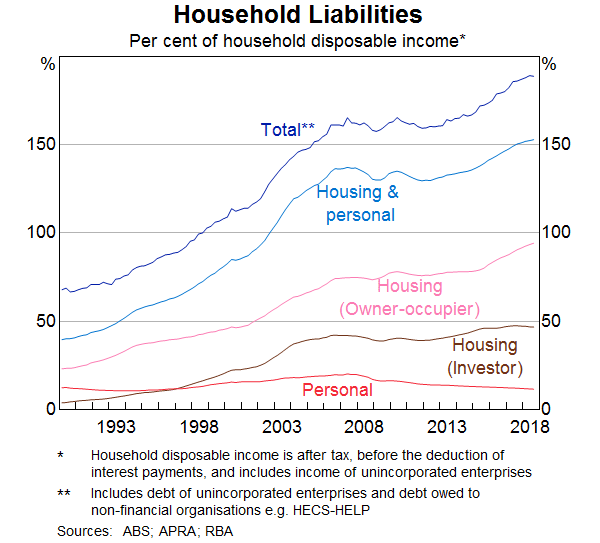Bulletin – March 2019 Finance Updates to Australia's Financial Aggregates
- Download 406KB

Abstract
The financial aggregates for Australia are important data compiled by the Reserve Bank that are used by policymakers to assess financial and economic activity of households and companies. From August 2019, the Reserve Bank will publish the financial aggregates using an improved framework based on a better data collection. This will enhance the quality of information available to policymakers and the wider community. This article gives an overview of the main changes.
What Are the Financial Aggregates?
The Reserve Bank publishes and monitors data on the stock of money and credit in Australia based on international statistical standards, much like central banks and statistical agencies in other countries. These data are called the financial aggregates. They can be used to help understand developments in financing and the economy.
The credit aggregates measure the funds borrowed by Australian households and businesses from financial intermediaries. Total credit can be broken down into housing credit, personal credit (such as credit cards) and business credit. The credit aggregates measure households' borrowing for purposes such as housing (whether owner-occupier or investment) and consumption (such as cars and holidays). They also measure how much businesses are borrowing for purposes such as investing in projects, buying assets or managing their cash flows.
Table 1 shows some of the data series currently published on the Reserve Bank's website. These are available both expressed as growth rates and as the value of credit outstanding at the end of each month. The entire data series can be found in Statistical Tables D1 and D2 on the Reserve Bank's website.
| Share of total credit Per cent | Share of GDP Per cent | |
|---|---|---|
| Household | 67 | 103 |
| – Housing | 62 | 95 |
| – Owner-occupier | 42 | 64 |
| – Investor | 21 | 31 |
| – Personal | 5 | 8 |
| Business | 33 | 50 |
| Total credit | 100 | 154 |
|
Sources: ABS; APRA; RBA |
||
The monetary aggregates measure the money and ‘money-like’ instruments – such as deposits – that the banking system owes to households and businesses.[1] Money can be held in different forms, for example, as banknotes in a wallet or as deposits in a bank account.
The Reserve Bank publishes five different monetary aggregates: currency, the money base, M1, M3 and broad money. These measures differ in the types of instruments that are included. For example, M1 contains only the most liquid forms of money such as banknotes and current deposits (i.e. funds that can be easily used to make payments), whereas broad money also includes term deposits and short-term debt securities issued by financial institutions in Australia. Table 2 shows how the monetary aggregates are currently defined. The data can be found in Statistical Tables D1 and D3 on the Reserve Bank's website.
| Measure | Description(a) | Share of nominal GDP Per cent |
|---|---|---|
| Currency | Holdings of notes and coins by the private non-bank sector | 4 |
| Money base | Currency + banks' holdings of notes and coins + deposits of banks with the RBA + other RBA liabilities to the private non-bank sector | 6 |
| M1 | Currency + current (cheque) deposits of the private non-bank sector at banks | 19 |
| M3 | M1 + all other deposits of the private non-authorised deposit-taking institution sector at banks (including certificates of deposit) + all deposits at credit unions and building societies | 111 |
| Broad money | M3 + other deposit-like borrowings (such as short-term debt securities) of banks and non-bank lenders in Australia from private sector entities outside the banking system | 112 |
|
(a) These descriptions abstract from some detail. See the financial aggregates release for more information. Sources: Doherty, Jackman and Perry (2018); ABS; APRA; RBA |
||
Why are the financial aggregates important?
The financial aggregates are used extensively by policymakers and the wider community. Monitoring changes in the stock of money and credit is important because it can help us understand more about what is happening in the economy. Monitoring changes in credit can also be helpful for identifying risks to financial stability. For example, rapid credit growth could signal stronger economic growth, but also increasing risks to financial stability, particularly if debt levels are already high.
Some examples of how the Reserve Bank uses the aggregates include the following:
- Data on borrowing for owner-occupier housing, investor housing and personal lending can assist in monitoring households' access to credit and lenders' willingness to lend. Housing credit data can depend on conditions in the housing market and can also influence conditions in the housing market.
- Data on business borrowings from banks and non-bank lenders form part of an assessment on financial conditions for businesses in Australia.
- The aggregates provide information on the composition of lenders' assets and liabilities. These exposures are relevant to assessments on financial stability in Australia.
- The Reserve Bank also combines data on the composition of banks' assets and liabilities with other information to assess developments in banks' profitability.
Graphs 1–4 show some of the financial aggregates data that can feature in the Reserve Bank's assessments of economic and financial conditions.




The Framework for Compiling the Financial Aggregates
This section briefly discusses the conceptual framework that underlies the financial aggregates. More comprehensive information on the framework can be found in the International Monetary Fund's (IMF) Monetary and Financial Statistics Manual and Compilation Guide (which has informed Australia's aggregates).
Every financial aggregate has three components:
- a set of financial instruments
- a set of financial intermediaries
- a set of counterparties to the financial intermediaries.
For the credit aggregates: the financial instruments are loans made by financial intermediaries to households and businesses, which are the counterparties to the financial intermediaries. The loans are assets of the intermediaries, and liabilities of the households or businesses. Using this framework, we can narrow down the scope of the aggregates to focus on particular areas of interest. For example, the Reserve Bank produces a credit aggregate called ‘investor housing credit’ by restricting the set of counterparties to households and the financial instruments to loans used to purchase housing for investment purposes.
For the monetary aggregates: the money and ‘money-like’ financial instruments are liabilities of the financial intermediaries and are assets held by households and businesses. Again, the scope of the aggregate can vary to focus on areas of interest.
A key challenge in compiling the aggregates is avoiding double counting. This requires keeping the sets of financial intermediaries mutually exclusive from the sets of counterparties. For example, if a financial intermediary borrows from another financial intermediary to extend a mortgage to a household, only the final loan to the household should be included in the credit aggregates.
In principle, the financial aggregates should be:
- produced using timely, reliable and accurate inputs, and be free from double counting;
- easily understood by and explained to users;
- available in various breakdowns to meet the analytical needs of data users without creating undue burden for compilation and publication;
- consistent with the general international principles for the compilation of financial aggregates while taking account of Australia's particular circumstances; and
- as robust as possible through time to changes in how particular financial instruments or the counterparties that issue and hold them are classified.
The Australian Prudential Regulation Authority (APRA) is the statistical agency for the Australian financial sector. APRA collects a large amount of data from banks and other financial institutions using various ‘forms’, which can be found on APRA's website. As part of this role, APRA collects data on behalf of the Australian Bureau of Statistics (ABS) and the Reserve Bank. The current version of this set of forms was introduced in 2002 and has not been comprehensively updated since then. The data from each reporting institution's forms are aggregated, and feed into ABS publications such as the National Accounts: Income, Expenditure and Product, the National Accounts: Finance and Wealth, and Lending to Households and Businesses, Australia.[2]
This collection is also what the Reserve Bank currently uses to compile the financial aggregates. Conceptually, the entities that report on this collection represent the financial intermediaries in the credit and money aggregates. Individual items are taken from the assets and liabilities of each reporting institution and then aggregated to a total using the principles outlined above.
The New Economic and Financial Statistics Collection
Over the past few years, APRA, the ABS and the RBA have worked to modernise the existing set of forms, and banks and other reporting institutions have adapted their infrastructure to be able to report on the new versions of these forms. This has been a large scale and complex project, involving considerable collaboration between the three agencies and the industry. The new set of forms are called the Economic and Financial Statistics (EFS) collection and will better meet the data needs of policymakers.
The EFS collection will be implemented in three phases.
- The first phase will focus on data used for the financial aggregates and national accounts finance and wealth estimates – discussed in more detail below.
- The second phase will update current forms on housing and business loan approvals. It will also provide much more granular information on banks' and other reporting institutions' lending, their liabilities and interest rates.
- The third phase will provide information on other aspects of reporting institutions' activity and performance, including profits, fees charged and activity in specific financial products and markets. The first phase national accounts aggregates will be used in addition to this performance data in the compilation of Australia's Gross Domestic Product (GDP).
The EFS collection will increase the reliability and accuracy of the inputs used to calculate the aggregates. One of the most important changes in the EFS is more detailed and precise definitions of the data to be reported. These definitions are accompanied by comprehensive guidance to assist institutions in reporting consistent data.
The guidance includes a Reporting Practice Guide and published responses to questions from reporting entities about the new forms. The guide explains the common principles underlying the EFS collection and elaborates on specific terms and concepts within the forms such that reported data should be more consistent across institutions. This, in turn, will increase the accuracy and reliability of the financial aggregates. The guidance is comprehensive, but it is worth pointing out a few items.
Clarifying definitions
A number of definitions have been clarified or updated to align with international standards for compiling economic statistics. These include the definitions of different types of deposits and industry sectors.
More broadly, an underlying principle of the EFS collection is that loans should be classified by their purpose, such as to purchase a house or to finance a business. The definitions of loan purpose types have been specified to seek to avoid ambiguity, an improvement on existing reporting in which institutions have sometimes used a variety of interpretations when reporting data.
This could have a significant effect on the reporting of owner-occupier housing loans, which EFS defines as being for the principal place of residence. This means a borrower can generally only have one owner-occupier housing loan, with all other housing loans by the same borrower classified as being for investment purposes (investor loans). This is not how banks and other reporting institutions have necessarily recorded housing loans in their own systems in the past.
The EFS collection includes updated definitions of residency status for households and businesses, which are consistent with the compilation of Australia's national accounts. Detailed guidance on how to classify counterparties and financial instruments by residency is now also provided, including for cases when households' or businesses' activities are spread across multiple countries.
Improving data quality
There is also separate guidance on how existing data quality standards apply to EFS reporting. This sets out the level of accuracy expected for specific EFS data and gives reporting entities a sense of where to focus their data quality management efforts.
The set of institutions that will form part of the financial aggregates will also change, which will further improve the accuracy of the aggregates. The aggregates will transition towards no longer including estimates of lending by non-bank entities that are not registered with APRA, which is mostly relevant for housing lenders that securitise their loans. Only a small number of these institutions currently report data to APRA, which are used to construct estimates of lending by all non-registered lenders. As a result of the small number of reporting institutions, these estimates are imprecise. Recent legislative changes mean that many of these entities will register with APRA and begin reporting data.[3] This will allow the Reserve Bank to transition away from including estimates for non-registered lenders in the credit aggregates.
Simplifying the conceptual framework
The conceptual framework has also been simplified and modernised, which will make the aggregates more accurate, easier to understand and more robust through time. A prominent example is the definition of M1 in the monetary aggregates. Conceptually, M1 should measure physical currency plus transferable deposits. However, M1 as currently published only includes chequing accounts at banks, and excludes all deposits at credit unions and building societies (CUBS). The new M1 will include all transaction deposits at both banks and CUBS.
Further technical changes to the framework can be found in the Appendix.
Changes to Existing Financial Aggregates Data
The EFS collection will significantly improve the quality of Australia's financial aggregates. The updated financial aggregates will be better aligned with the principles outlined above. As a result, the new data will be more accurate and provide policymakers with a better understanding of developments in financial conditions in Australia.
The more detailed guidance accompanying EFS, along with some definitional changes, are likely to result in changes to the financial aggregates, some of which may be significant. The RBA and ABS will receive parallel run data for the new financial aggregates in April, which will give us an indication of the scale and direction of revisions.
The new guidance on principal place of residence is expected to be reflected in lower owner-occupier housing lending and higher investor housing lending in the new aggregates, all other things being equal; and M1 will be higher with the inclusion of all transaction deposits. However, given the holistic nature of the changes, it is too early to say what the broader impact of the introduction of the EFS on these aggregates is likely to be.
It may also take time for reporting entities to get used to the new forms. APRA, the ABS and the RBA have been engaging with the industry about EFS on a regular basis, with the aim of answering as many questions from industry as possible. Nevertheless, the scale and complexity of EFS means that there may be some large revisions to data (over and above normal) for some time after the new financial aggregates are first released in August 2019.
What's Next?
The EFS collection will provide more information relating to the aggregates, which creates the opportunity for the Reserve Bank to publish more detailed breakdowns as part of its financial aggregates publication. The Reserve Bank will make some of this new information publicly available if it is assessed to be of sufficient quality and judged to be of wider interest to users of the financial aggregates statistics.
The financial aggregates are also just the first phase of EFS. The second phase will provide policymakers with much more detailed data on: loan approvals; housing, personal and business lending, including interest rates on different types of lending; and financial intermediaries' liabilities. These data will be of interest to the wider community and further information will be published by the Reserve Bank over the years ahead.
Appendix
The appendix has further details about the upcoming changes to the financial aggregates.
Footnotes
The authors are from Domestic Markets Department. From the April 2023 release, changes have been made to the financial aggregates to add series that exclude lending to warehouse trusts in business credit. More information is available in the Change Notice published 21 April 2023. [*]
See Doherty, Jackman & Perry (2018) and Kent (2018) for a comprehensive primer on the concept of money and how it is created. [1]
In the ABS release, lending refers to loan approvals. [2]
The legislation is the Financial Sector (Collection of Data) Act 2001. [3]
References
ABS (Australian Bureau of Statistics) (2019), ‘Australian National Accounts: National Income, Expenditure and Product’, abs.gov.au site. Available at <http://www.abs.gov.au/ausstats/abs@.nsf/mf/5206.0>.
ABS (2019), ‘Australian National Accounts: Finance and Wealth’, abs.gov.au site. Available at <http://www.abs.gov.au/AUSSTATS/abs@.nsf/Lookup/5232.0Main+Features1Sep%202018?OpenDocument>.
APRA (Australian Prudential Regulation Authority) (2018), Reporting Practice Guide. RPG 702.0 ABS/RBA Data Quality for the EFS Collection. Available at <https://www.apra.gov.au/sites/default/files/efs_042018_rpg-702.0-absrba-data-quality-for-the-efs-collection-april-2018_clean.pdf>
APRA (2018), Reporting Practice Guide. RPG 701.0 ABS/RBA Reporting Concepts for the EFS Collection. Available at <https://www.apra.gov.au/sites/default/files/rpg_701.0_reporting_guidance_-_absrba_reporting_concepts_2.pdf>.
APRA (2019), ‘Economic and financial statistics (EFS) frequently asked questions’, apra.gov.au site. Available at <https://www.apra.gov.au/frequently-asked-questions-faqs-economic-financial-statistics-efs>.
APRA (2019), ‘Modernised economic and financial statistics’, apra.gov.au site. Available at <https://www.apra.gov.au/modernised-economic-and-financial-statistics-efs>.
APRA (2019), ‘Plain English Taxonomy’, apra.gov.au site. Available at <https://sbr-pet.apra.gov.au/>.
Doherty E, B Jackman and E Perry (2018), ‘Money in the Australian Economy’, RBA Bulletin, September Quarter.
IMF (International Monetary Fund) (2018), Monetary and Financial Statistics Manual and Compilation Guide. Available at <https://www.imf.org/en/Publications/Manuals-Guides/Issues/2018/09/21/Monetary-and-Financial-Statistics-Manual-and-Compilation-Guide-43001>.
Kent C (2018), ‘Money – Born of Credit?’, Remarks at the Reserve Bank's Topical Talks Event for Educators, 19 September.
RBA (Reserve Bank of Australia) (2019), ‘Financial Aggregates’, rba.gov.au site. Available at <https://www.rba.gov.au/education/resources/in-a-nutshell/pdf/financial-aggregates.pdf>.
RBA (2019), ‘Financial Aggregates 2019’, rba.gov.au site. Available at <https://www.rba.gov.au/statistics/frequency/fin-agg/2018/>.
RBA (2009), ‘Measuring Credit’, RBA Bulletin, September, pp 15–20.